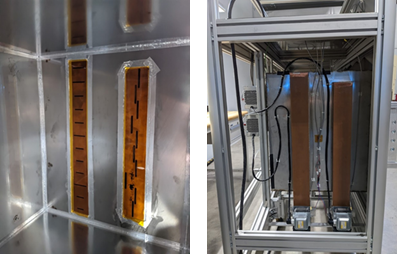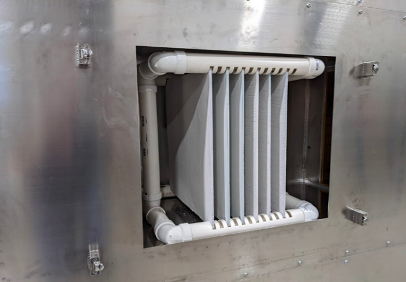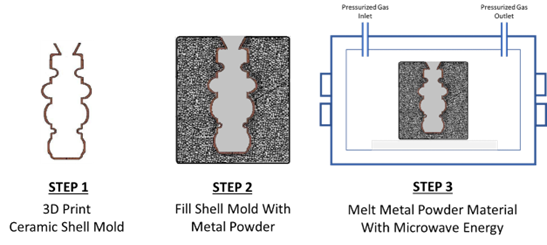Metallum3D Successfully Completes Validation Tests of New Microwave Heating Process for Additive Manufacturing

Over the last two years, Metallum3D has been developing a new type of microwave heating process that uses non-resonant, cross-polarized slotted waveguides and a granular susceptor material to evenly distribute microwave energy during processing. Until now, microwave energy has not been successfully used in additive manufacturing applications due to the uneven microwave energy distributions of the current multi-mode resonant technology. Recently, Metallum3D completed the construction of a second-generation microwave furnace that implements non-resonant, cross-polarized slotted waveguides as a microwave energy feeding system. A picture of the microwave furnace is shown below in Figure 1.
The performance of the non-resonant, cross-polarized slotted waveguides used in this microwave furnace has been simulated using the electromagnetic simulation software CST Microwave Studio. The simulations showed that the non-resonant, cross-polarized waveguides generate an electric field with uniform microwave energy distribution. Figure 2 shows a 3D CAD model of the non-resonant, cross-polarized waveguide pair and a simulation of the electric field being generated in free space. The uniform color distribution within the electric field cross-section is indicative of uniform microwave energy distribution.
A separate simulation was conducted to evaluate the performance of the non-resonant, cross-polarized slotted waveguides as mounted in the microwave cavity. Figure 3 shows the simulation of the electric field generated by the non-resonant, cross-polarized waveguides at the mid-section of the microwave cavity. The uniform color distribution within the electric field cross-section is indicative of uniform microwave energy distribution.
A recent validation study completed by Metallum3D utilized cast gypsum plates saturated in a cobalt chloride solution and thermal imaging to map the actual microwave energy distribution of the non-resonant, cross-polarized waveguides under operating conditions. After exposing the plates to a microwave field, the heating of the plates causes a color change in the cobalt chloride that forms a color map of the microwave energy distribution. The visual color map results were cross-validated with thermal imaging.
The Metallum3D microwave furnace uses two sets of waveguides, with each waveguide being directly fed by 1.5 kW magnetrons for a total of 6kW. Figure 4 shows the internal and external waveguide arrangement.
For validation testing, 6 casted plates were vertically loaded into the microwave with the aid of a PVC fixture as shown in Figure 5.
Microwave heating of the plates resulted in a uniform color change of all the plate surfaces from a pinkish-grey color to a bluish-gray color. There was no color banding in any of the plate surfaces indicating homogenous microwave heating throughout the entire microwave cavity volume. The visual results obtained were then cross-validated through thermal imaging, which also showed uniform microwave heating throughout the surfaces of all the plates. The actual microwave energy distribution of the non-resonant, cross-polarized slotted waveguides is in good agreement with the predicted microwave energy distribution previously obtained through electromagnetic simulation. A technical white paper detailing the validation testing and results is available for download at the following link:
Metallum3D Technical White Paper Download
The successful validation of this new type of microwave heating process by Metallum3D is creating new opportunities for processing additively manufactured parts. Our Microwave Furnace is configured for both microwave sintering and microwave digital casting. For microwave sintering, parts are embedded in a granular susceptor material within a microwave transparent and thermally insulating box for rapid microwave sintering, which is up to 90% faster than conventional sintering. A schematic representation of the Metallum3D microwave sintering process is shown in Figure 6.
Microwave Digital Casting is a process that combines additive manufacturing and microwave heating to create a new agile and cost-effective casting process that bypasses the need to pour molten metal into a mold. The first step in the microwave digital casting process is to 3D print a sacrificial ceramic shell mold. The second step is to fill the ceramic shell mold with a metal powder and embed it in our granular susceptor material. The third step is to place the embedded mold in our microwave furnace to melt the metal powder within the mold to form a cast part. Figure 7 shows the basic steps of the Metallum3D Microwave Digital Casting process.
As a result of the successful validation of our new microwave heating process, Metallum3D in conjunction with P3 Additive is launching a Beta Customer Program. Under this program, we are looking to identify 10 customers that have applications that could benefit from implementing our Microwave Sintering or Microwave Digital Casting process. Use the link below to apply to the Beta Customer Program.
Metallum3D Beta Customer Program
Subscribe to Our Email Newsletter
Stay up-to-date on all the latest news from the 3D printing industry and receive information and offers from third party vendors.
You May Also Like
Creality Begins Selling HALOT-MAGE S: Setting New Standards in Precision 3D Printing
Creality, a leading innovator in consumer-grade 3D printing technology, proudly introduces the HALOT-MAGE S, the latest breakthrough in high-resolution 3D printing. With its cutting-edge features and user-centric design, the HALOT-MAGE...
Farsoon Showcases Comprehensive 3D Printing Solutions, Automation, and More at TCT Asia
This year’s TCT Asia event showcased just how much the Asian additive manufacturing (AM) market has grown, with Eplus3D’s 64-laser metal 3D printer alone acting as a synecdoche for China’s...
Creality Launches Ender-3 V3 Plus: Bigger CoreXZ for Unprecedented Performance
Embracing a journey of innovation and excellence, Creality’s Ender-3 series has established a distinguished path in the field of 3D printing. From the entry-level Ender-3 V3 SE to the feature-rich...
Laser Wars: Eplus3D Unveils Metal 3D Printer with up to 64 Lasers
Now that the laser wars in the powder bed fusion (PBF) space have, for the most part, moved to China, original equipment manufacturers (OEMs) there are in fierce competition. Eplus3D...







































